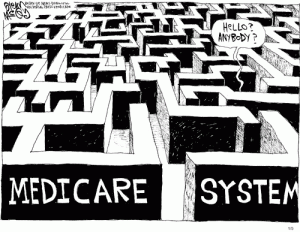Today I am pleased to say, “Nanny, Nanny, Nanny, I was right.”
By Steve Moran
Recently we published an article titled Aggressive REITs Changing Operators: A Refreshing Response… and, as I expected, it was a popular read. It also generated some interesting comments here is one of them:
I think you are missing the point. There seems to be a suggestion that stand-alone memory care is the problem and I think you have it wrong. I don’t think stand-alone memory care is a bad asset class. We have some and they all run well, provide excellent care for residents with very unique needs. Maybe the problem is how they were operated. (Heavily edited for clarity and privacy.)
This is a legitimate comment and really raises two questions:
-
Is stand-alone memory care a bad idea, a bad product?
-
Who owns the blame for the broken REIT/Senior Living relationship . . . or is it really broken?
This is worth two articles and I want to start by tackling the freestanding memory care question first.
Stand-alone Memory Care — Foolish or Smart?
What I loved about Thrive’s response was they mostly owned the responsibility for the 6 stand-alone memory care communities being moved to a different operator, which I found so refreshing and continue to have great admiration for their taking ownership of that.
I started Senior Housing Forum almost exactly 8 years ago and after about 24 months realized I could legitimately ask for press passes to industry events. It came time for NIC maybe 6 years ago and it was at a time when people mostly said, “Steve Moran who?” or “Senior Housing Forum . . . what is that?” or “What is with that weird guy writing those articles?”
At that time I knew absolutely no one at NIC. I found an email and sent in a request for a press pass and they really hurt my feelings when they basically said I was not significant enough to get a press pass.
I Still Wanted To Know What Was Going On . . .
By then, I had started making some connections with senior living leaders and so I sent out a short email asking maybe 20 or 30 leaders what their big takeaways were, and got a ton of responses, which made my hurt feelings go away . . . well not really so much.
The single big takeaway almost everyone offered up was that Memory Care was big. Not just big, but HUGE, MASSIVE. It was like the goose that laid the golden egg, and that the goose would never grow old and die.
The sentiment was that dementia was such a big problem that it would be impossible for the industry to build enough memory care communities or apartments to ever, ever, in the next twenty years, meet the demand. There was this sense that building memory care communities was like printing money.
Backing up that assertion were stories . . . true stories of operators building 40-, 50-, 60-resident memory care communities where they had an 8 to 12-month fill-up projection and then filling them in 4, 6, or 8 weeks.
And Yet . . .
And yet, even after hearing almost everyone say, you could not build enough memory care, I thought “naw, that is never true about anything” and expressed that opinion.
And today I am pleased to say, “Nanny, Nanny, Nanny, I was right.”
Is Freestanding Memory Care Good or Bad?
The answer, of course, is that it depends, maybe a little on the market and maybe a little on programming, but, at the end of the day, it is almost exclusively good or bad because of how good the operator is. We are not seeing capital providers take back freestanding memory care communities and repurposing them because it was a bad idea. But rather they are taking them back and giving them to new operators believing a new operator can operate better than the old one.
Largely I believe this to be a reasonable approach. The challenge is that we have a lot of product in memory care and other levels of care that is more or less the same, meaning consumers have no compelling reason to pick one community over another. This has little or nothing to do with being freestanding.
One can make a compelling case that freestanding memory care is actually in a better position to do the best job of serving residents with memory impairment. They can train staff to be focused on these unique needs. There is no need to attempt to balance the needs of memory care and non-memory care residents.
At the end of the day, it is much more about the operator than anything else . . . than everything else.










